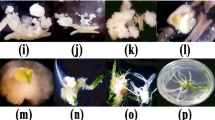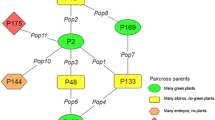Summary
Marked effects of genotype on wheat anther culture response have been observed. Genetic factors have been recognised to be one of the major contributors to in vitro responses of cultured wheat tissues. In wheat anther culture, embryo induction, plant regeneration and albina/green ratio have been determined to be heritable traits. Using Chinese Spring (CS) monosomic 1D, single chromosome substitution lines of chromosome 5B or chromosome arm 5BL from Chinese Spring into six varieties, and F1 hybrids heterozygous for the 1B chromosome structure (1BL-1BS/1BL-1RS), the anther culture response was studied: genes on CS1D chromosome and 5BL chromosome arm increases the embryo frequency; gene(s) involved in regeneration ability are located on the 1RS chromosome arm; a gene increasing albina frequency is located on Chinese Spring 5B chromosome. Our results support the fact that without gametic selection, a differential development occurred from the particular classes of microspores carrying genes for higher regeneration ability. Moreover, in some crosses, a few genes with major effects were involved in determination of anther culture response.
Similar content being viewed by others
References
Agache S, De Buyser J, Henry Y, Snape JW (1988) Studies on the genetic relationship between anther culture and somatic tissue culture abilities in wheat. Plant Breeding 100:26–33
Bullock WP, Baenziger PS, Schaeffer GW, Bottino PJ (1982) Anther culture of wheat (Triticum aestivum L.) F1's and their reciprocal crosses. Theor Appl Genet 65:155–159
Charmet G, Bernard S (1984) Diallele analysis of androgenetic plant production in hexaploid Triticale (x triticosecale, Wittmack). Theor Appl Genet 69:55–61
Datta SK, Wenzel G (1987) Isolated microspore derived plants formation via embryogenesis in Triticum aestivum L. Plant Sci 48:49–54
De Buyser J, Henry Y (1979) Androgenèse sur des blés tendres en cours de sélection. 1. L'obtention des plantes in vitro. Z Pflanzenzücht 83:49–56
He D, Ouyang J (1984) Callus and plantlet formation from cultured wheat anthers at different developmental stages. Plant Sci Lett 33:71–79
Henry Y, De Buyser J (1981) Float culture of wheat anthers. Theor Appl Genet 60:77–79
Henry Y, De Buyser J (1985) Effect of the 1B/1R translocation on anther culture ability in wheat (Triticum aestivum L.). Plant Cell Rep 4:307–310
Köhler F, Wenzel G (1985) Regeneration of isolated barley microspores in conditioned media and trials to characterize the responsible factor. J Plant Physiol 121:181–191
Lazar MD, Baenziger PS, Schaeffer GW (1984) Combining abilities and heritability of callus formation and plantlet regeneration in wheat (Triticum aestivum L.) anther culture. Theor Appl Genet 68:131–134
Mettin D, Bluthner WD, Schlegel G (1973) Additional evidence on spontaneous 1B/1R wheat-rye substitutions and translocations. Proc 4th Int Wheat Genet Symp, Missouri Agric. Exp Sta, Columbia/MO, pp 179–184
Miller TE (1984) The homologous relationship between the chromosomes of rye and wheat. Current status. Can J Genet Cytol 26:578–589
Ockendon DJ, Sutherland RA (1987) Genetic and non-genetic factors affecting anther culture of Brussel sprouts (Brassica oleracea var. gemmifera). Theor Appl Genet 74:566–570
Ouyang J (1986) Induction of pollen plants in Triticum aestivum. In: Hu H, Yang H (eds) Haploids of higher plants in vitro. Springer, Berlin Heidelberg New York, pp 26–41
Pelletier G, Ilami M (1972) Les facteurs de l'androgenèse in vitro chez Nicotiana tabacum. Z Pflanzenphysiol 68:97–114
Raquin C (1982) Genetic factors in anther culture of Petunia. Theor Appl Genet 63:151–154
Snape JW (1987) Transfer of cross ability in wheat. Annual Report Plant Breeding Institute, 1986
Snape JW, De Buyser J, Henry Y, Simpson E (1986) A comparison of methods of haploid production in a cross of wheat, Triticum aestivum. Z. Pflanzenzücht 96:320–330
Wei ZM (1982) Pollen callus culture in Triticum aestivum. Theor Appl Genet 63:71–73
Xu Z, Sunderland N (1981) Glutamine, inositol and conditioning factors in the production of Barley pollen callus in vitro. Plant Sci Lett 23:161–168
Zhang YL, Li DS (1984) Anther culture of monosomics in Triticum aestivum. Hereditas 6:7–10
Author information
Authors and Affiliations
Additional information
Communicated by G. Wenzel
Rights and permissions
About this article
Cite this article
Agache, S., Bachelier, B., de Buyser, J. et al. Genetic analysis of anther culture response in wheat using aneuploid, chromosome substitution and translocation lines. Theoret. Appl. Genetics 77, 7–11 (1989). https://doi.org/10.1007/BF00292308
Received:
Accepted:
Issue Date:
DOI: https://doi.org/10.1007/BF00292308




